I visited my favorite cemetery today. I don’t have kin or anyone I know buried there. Still, I stop by twice a year, head to the back where the oldest headstones are, and tidy up. It’s a small graveyard just a few miles from my house simply called Ridge Cemetery. No saints have sway here.
Tucked back on the outskirts of town, I drive down an old dirt road to the entrance. During the fall, it seems the leaves cling to the trees longer here than on the next road over where the pavement begins.
Old lilac bushes, cedars, maples and my favorite; a sprawling crooked horse chestnut tree stand sentinel throughout the older plots. It’s these old guardians I think that fascinate me most about this particular cemetery. It feels like they are not just trees, but have taken on some of the life that those buried here have left behind. The wind always seems to be howling when I visit on this day, creating cascades of leaves and swaying branches. For a place of the dead, it feels so alive.
The seclusion draws me in, though today there are three cars here, closer to the front of the cemetery where the newer graves are. Even though I don’t know the people beneath the soil, I come to read their names, clean off their headstones, maybe leave a little bit of homemade bread or dried herbs from the garden for them. I’m here on the eve of the thinnest day of the year to silently repeat the belief that the dead should be remembered, even if their lives, whittled down to the inscriptions on their gravestones, have been nearly worn off with time.
There is an old Polish holiday called Dziady (translating to Grandfather’s or Forefathers Eve) which takes place on this day. It is nearly identical to the Mexican Dia De Los Muertos. Candles are lit to and from and all around the cemetery, food is brought to the family grave plots and feasts are held right there on top of the grave.
It was a celebration of lineage and acknowledgment that life does not end with death. While it dates back to pagan times, the church banned the holiday generations ago, renaming it All Saints Day. The name and some of the rituals have changed, but you will still find many graveyards in Poland lit up with rivers of burial candles each November 1st.
Our cemeteries are depressing in comparison. We’ve lost so much. So maybe I can’t celebrate the dead like we used to, but I can keep a little candle lit.
As I walk through the cemetery I think about the lives lived as I read the names. I wonder what their hopes, dreams, and fears were. I wonder what the world was like when they were alive and how they looked at the world when their lives came to an end. I see the tiny headstones, some with simple initials carved in, some simply blank.
I contemplate the folks under the larger stones and fenced in plots, so grand they must have been in their time, though many now stand crooked as the ground ebbs and flows with the years. I wonder who they were to this tiny rural town. I see some newer stones tucked back here with names reflecting the older stones. I guess at how long their family has been here, how many generations find rest in the same soil.
Even though my tradition isn’t the same as the old traditions, there is something special here too. I get to be a part of not just one family, but all the families back here who have no one left to visit. I often find myself returning to certain plots year after year.
The small family buried under the horse chestnut tree is one of them. The large stone reads “Wagar”. One smaller stone tells us this is the father, Wellington. The next stone in line marks the mother, Elizabeth. The last stone is for the daughter, Olive Irene. The dates on her stone tells me she only lived to see two years. Bronchitis, I found out later, was the cause of her death. It is such a common tragedy in this half of the cemetery.
This is an old country graveyard, left to the care of nature. But I’m reminded of the Burying Point in Salem, Massachusetts where folks got creative with their epithets. One that stuck with me was Mary Ingalls Bray, whose headstone read:
Depart my friends, dry up your tears,
Here I must be ‘till Christ appears.
Death is a debt to nature due,
I’ve paid the debt and so must you.
It was almost as if she knew one day the paths would be chained off and the gravestones would become a spectacle for tourists. I could almost hear her laughing quietly across the centuries. The Burying Point is a cemetery that is far from abandoned, but the reverence is still missing.
I sit and sketch for a bit back in my little cemetery, doing my best to banish the feeling that maybe it’s weird to hang out in a graveyard. The insistent wind has me checking in my mirrors every other minute, sure that someone has pulled up behind me, about to see what I think I’m doing here.
But each time I look up, no one is there. A small squirrel darts between stones. Otherwise I’m alone.
I come home to make some pumpkin bread while listening to the crows outside my window mingling with the lonely sounds of my windchime. Everything feels a bit more somber today. Though I appreciate days like this, when we can contemplate the balance of life and death without trying to mask the darkness.
Enjoy the rest of this liminal night. Light a candle for a loved one or stranger passed.
Much love,
Val
P.S. Feel free to share, it’s always appreciated!
If you want to move deeper into a seasonal land-based life, consider ordering my 2025 Lunar + Seasonal Planner. Because learning to live in tune with the land doesn’t come from grand gestures or life-altering shifts, but rather from daily routines, devotions and observations of the land and how we relate to it.
This yearly planner weaves seasonal land-based practices with modern living so that you can live more intentionally and presently within every season of your life. It was created for the plant people, the land lovers, the gardeners, and the seekers to plan their lives around the rhythms of the earth as our ancestors have for thousands of years. More than just a planner, it is a practical yet spiritual guide to living, working, gardening, and celebrating in tune with the ever-shifting world around us.













My Brother-in-law's mother, Marie, was from Gladwin. He and my sister had a cabin on the Tittabawassee River and later split their year between a larger home outside of Gladwin and snowbirding in Florida. I always enjoyed my visits there and have many wonderful memories. I wonder if some of those old graves go back to Marie's family.
My mother, father and I used to explore old cemeteries in the then small towns, like Novi, west of Detroit. My mother especially found it comforting after one of my siblings died at 14.
I still explore cemeteries when I travel including one in an abandoned village in Greenland a month ago. There were white crosses but no stones there.
Love old graveyards -- The one closest to me know is very small and wild---a winding narrow path leads up to it on from the road, Bingham Hill. Those buried there are all from families who first settled in this area. People leave coins and little tokens on the gravestones. It is a very peaceful place. I was swooped by a great horned owl one day as I was walking down the path back to the road. In the 90's I visited Kensal Green Cemetery in England. It was just 2 years after I lost my parents. The epitaph on the grave of George Bidder, born 8-18-1836 - Died 2-1-1896, gave me comfort and hope. It said:
"One who never turned his back but marched breast forward. Never doubted clouds would break. Never dreamed, though right were worsted, wrong would triumph. Held we fall to rise, are baffled to fight better, and sleep to rise."
Thank you for your post!